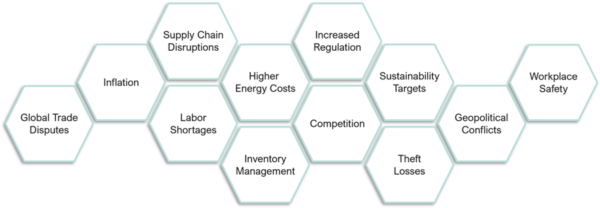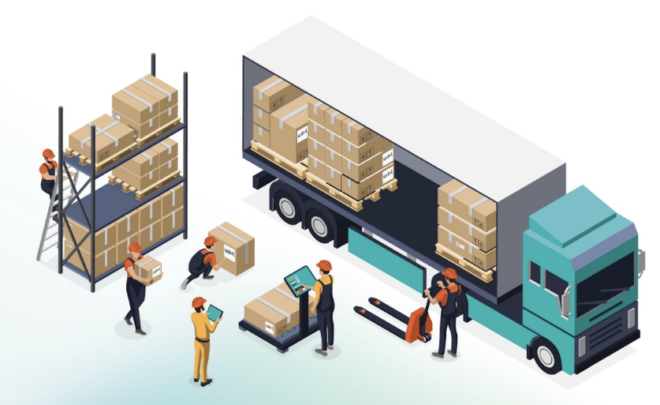If you are a Bluetooth® developer, marketer, or aficionado who’s new to the Industrial IoT (IIoT), this article summarizes for you some basics that will help give your IIoT learning curve a quick boost and, more importantly, explain why Bluetooth® technology is becoming a major player in the IIoT.
Industrial IoT – What Is It?
If you do an online search, you will find that there are multiple definitions, technologies, and applications associated with the IIoT. From Infineon’s perspective, and keeping things as simple as possible, the industrial IoT is simply a digitalization process for industries where industry can mean a manufacturing activity or a distinct group of productive, profit-making enterprises.
Digitalization refers to the act of integrating and leveraging digital technologies in all areas of a business to transform and optimize operations, processes, models, etc.
Industrial IoT – Why Is It Relevant?
A digitalization process involves significant investment and effort, so you must wonder: What motivates enterprises to consider or pursue such transformation?
Very simple, enterprises are constantly facing growing challenges that impact their profitability and competitiveness, some of which are captured in Figure 1. Through the IIoT, enterprises acquire powerful technological capabilities useful to manage, mitigate, or overcome many of these challenges. That’s what makes the IIoT relevant.

Figure 1 – Growing challenges motivating enterprises to adopt the IIoT
Industrial IoT – What Can It Do?
In terms of functionality, IIoT devices and systems enable sensing, control, computing, communication, networking, commissioning, and interfacing abilities that, all together, allow organizations to conduct actions over assets, processes, products, and/or workers, such as:
![]()
- Collecting data, processing it, and using it to drive automated, intelligent decision making
- Monitoring and tracking, continuously, in real time and remotely
- Introducing control or management mechanisms to optimize asset or business-related parameters like usage, cost, energy, efficiency, etc.
- Improving or enhancing human interaction or interfacing
Exploiting such abilities and actions strategically can lead to the maximization of business uptime and the optimization of resources and productivity. Also, new services or features for existing products can be introduced to enable new business models or add revenue streams.
To add more color, below are two examples that illustrate what the IIoT can do.
Sensing and Automation
- Allows modernizing legacy or existing machinery and facilities
- Data collected on such assets permits better monitoring and assessing performance, maintenance, or utilization
- Automated controls responding to such data can be exploited to manage operation and energy costs more effectively to optimize uptime and productivity, enable workplace safety measures, eliminate human errors, etc.
Monitoring and Tracking
- Gives continuous visibility into the status or location of products, processes, workers, etc.
- Allows detecting and reacting to production or distribution issues quickly and mitigate their impact
- Enables inventory management optimization options
- Helps detect and minimize theft and related loss
Industrial IoT – Key Factors
If the IIoT is so great, everyone must be racing to bring IIoT solutions to the market then, right?
Yes and no. The truth is, the potential and forecasts for the IIoT are tremendous and there is certainly a lot of activity going on in the IIoT space. However, there are many critical factors to industrial customers and system integrators that make designing, deploying, and commercializing IIoT solutions non-trivial. Figure 2 captures some of the main ones.

Figure 2 – Key factors for industrial customers and system integrators
From the start, there are three fundamental factors to consider always in the industrial space: performance, reliability, and cost. In an industrial setting, things must work as expected always, exactly when needed, consistently, and delivering the highest return on investment as quickly as possible.
Then, from a consumer perspective (e.g., those with decision-making power to bring IIoT into a factory, enterprise, etc.), other crucial factors to account for include security, longevity, ease of use, platform support, robustness, and technical support. And from a systems integration view, key additional factors would be protocols, energy efficiency, and size. Justifications for why are all these important are given in the next table.
With so many factors at play, you can easily infer two things:
- There is no silver bullet when it comes to developing an IIoT solution and bringing it to market
- The number of IIoT device or solution suppliers able to check all the boxes is small
![]()
NEW MARKET RESEARCH
The Ambient IoT – The Emergence of a New Class of Bluetooth® IoT Devices
This report defines the Ambient IoT, outlines targeted use cases, and highlights the next steps needed to capitalize on the Ambient IoT opportunity. It also explains the central role of Bluetooth® technology in addressing Ambient IoT use cases, characterized by its low power consumption, low cost, flexibility, interoperability, and scalability.
Key Factors
- Performance: Solutions adopted must always work as expected under all specified conditions/scenarios.
- Reliability: Solutions adopted must perform the intended function consistently, without failure, throughout their rated lifetime.
- Cost: Solutions adopted must deliver the highest ROI as quickly as possible.
- Security: Solutions adopted must pose zero risk to the security of operations, products, business reputation, etc. Also, they must be updatable for protection against new and future threats.
- Longevity: Solutions or suppliers chosen must guarantee the longevity necessary to recover the investment, maintain and upgrade adopted solutions, profit over the long run, etc.
- Ease of Use: Solutions considered must be easy to evaluate, design with, deploy, maintain, etc. for developers and simple to use for the end users.
- Platform Support: Solutions adopted must be scalable, compatible with relevant ecosystems, interoperable with existing and future products or systems, based on common and reusable software/tools, etc.
- Robustness: Solutions chosen must deliver the ruggedness and quality required for an industrial environment.
- Technical Support: Suppliers selected must offer the expertise and support to help minimize R&D time, meet regulatory requirements, help integrate new systems with old, deploy upgrades or new features easily, minimize downtimes if an issue comes up, etc.
- Protocols: Solutions chosen must support protocols for communication, networking, security, safety, etc. suitable to meet customer targets for performance, reliability, cost, security, upgradability, etc.
- Energy Efficiency: Solutions chosen must support diverse energy operation modes and give options to achieve the highest efficiency possible.
- Size: Solutions chosen must be optimally sized to meet use case needs but also minimize cost.
Wireless in the Industrial IoT
![]()
Wireless connectivity is a foundational building block for the IIoT and technologies enabling direct cloud access. Wi-Fi and cellular were primary choices in the early stages. However, not every IIoT device or application demands cloud connectivity or the horsepower of Wi-Fi (e.g., wide channel bandwidth, tens or hundreds of MB throughput, a powerful application or host processor, unrestricted power consumption, etc.), or the cost and risk associated with operating in a licensed frequency band. Also, modern IIoT system architectures involve diverse types of device, with different design and performance requirements (e.g., gateways, control panels, end nodes, wireless infrastructure, etc.) where, in many cases, energy efficiency and low cost are top priorities. Because of this, Bluetooth® technology has gained major traction and is poised to grow its presence in the IIoT significantly.
Industrial IoT – Why Bluetooth Technology?
Bluetooth® technology is a wireless communication standard that, originally, was intended to replace cable connections to personal electronic devices and form short-range personal area networks (PANs).
Over time, the scope and reach of Bluetooth technology have been largely expanded with the addition of new capabilities and features through periodic revisions to the Bluetooth® Core Specification, some of which are highlighted in the next table.
Bluetooth® Core Specification
- Bluetooth® Core 4.0: Introduced the Bluetooth Low Energy mode of operation, enabling battery-powered solutions that can run from a coin cell battery for years.
- Bluetooth® Core 5.0: Added significant transfer speed and range improvements with LE 2M and LE Coded and also enabled higher data communication in a connectionless mode with Extended Advertising.
- Bluetooth® Core 5.4: Introduced Periodic Advertising with Responses (PAwR) which allows connectionless, two-way, one-to-many data communication.
- Bluetooth® Core 6.0: Rolled out Bluetooth Channel Sounding, a fine-ranging feature useful to estimate the distance between connected devices precisely and securely, enabling proximity awareness, locating, and tracking applications.
![]()
FEATURED PAPER
Bluetooth® Channel Sounding: A Technical Overview
This paper provides an overview of the forthcoming update to the Bluetooth® Core Specification. The update adds Bluetooth Channel Sounding, a new feature that enables secure fine ranging between two Bluetooth devices.
oday, Bluetooth technology is suited to support the range, robustness, security, and networking topology requirements of diverse industrial applications. Moreover, as result of the success Bluetooth technology has had in battery-powered consumer applications for mass markets, Bluetooth devices (e.g., SoCs and modules) have been greatly optimized for minimal size, cost, and energy consumption which are all desirable characteristics for industrial applications as well.
In a nutshell, these are ten of the reasons why Bluetooth technology is a key player in the IIoT today and, more importantly, projected to have tremendous growth in the near and long term.
![]()
- Energy Efficiency: Energy efficiency is the essence of Bluetooth Low Energy (LE). Battery or ambient-powered industrial applications like tags for asset tracking or electronic shelf labels (ESL) demand the highest efficiency possible and there is no better wireless technology than Bluetooth to deliver it.
- RF Performance: State-of-the-art Bluetooth devices achieve an outstanding RF link budget and support features like frequency hopping and LE channel classification to help avoid/mitigate RF interference. It is great for operating in industrial spaces (e.g., warehouses, factories, etc.).
- Cost and Size: Bluetooth devices are extremely cost competitive since they are typically targeted for high-volume applications. Their sizes keep shrinking with new process nodes and through cost-driven design optimizations. ICs in the market today can be as small as 3.6 mm2.
- Throughput and Long Range: Bluetooth LE can support a raw throughput of 2 Mbps which is appropriate for a wide range of industrial applications, and its range has improved drastically (> 5 km) with the introduction of LE Coded and features like Advertising Coding Selection.
- Multi-Protocol Support: Bluetooth technology is widely supported in multi-protocol devices that combine it with Wi-Fi, 15.4, etc. Proven co-existence mechanisms implemented in hardware or software to coordinate multiple radios in a collocated setting are available.
-
Network Topologies: Bluetooth technology supports a variety of networking topologies, including point-to-point, broadcast, and mesh that enable one-to-one, one-to-many, or many-to-many device communication, in connected or connectionless modes. It is great for IIoT use cases with diverse network performance, node count, or energy efficiency needs.
- Security: Bluetooth technology offers robust security capabilities with secure pairing at the core. Pairing gives devices resources to enable link encryption, privacy, and data signing. Private addresses for tracking protection are also supported. Modern Bluetooth devices integrate dedicated security subsystems in hardware as well.
- Modules: Many vendors offer complete system solutions integrating Bluetooth ICs and all external components needed (e.g., antenna, XTALs, passives) in miniaturized PCB or SiP modules, with regulatory and standards-based certifications included. It is great to add Bluetooth technology to multiple designs for fast development/time-to market, etc.
- Standardization: Benefits of Bluetooth standardization include operating in a globally available unlicensed frequency band, interoperability with devices from different vendors, access to a large pool of suppliers and to a global ecosystem of devices/software/solutions, efficiency and path to scalability, future-proofing, etc.
- Platform Support: Bluetooth technology is available in all tablet and mobile device platforms used in industrial settings for access, device provisioning, interaction through smartphone apps, etc.
Bluetooth Applications in the IIoT
For reference, below are some examples of IIoT applications where Bluetooth LE is being used.

Key Takeaways
The IIoT is a digitalization process for industries that gives them powerful capabilities to manage or mitigate growing challenges impacting their profitability and competitiveness. The benefits and potential offered by the IIoT are crystal clear, but the numerous relevant factors to account for in an industrial setting make the design, deployment, and commercialization of IIoT solutions non-trivial. Wireless connectivity is fundamental for the IIoT and Bluetooth technology has evolved into a key wireless technology ready to grow its position in the IIoT space exponentially. We have given 10 reasons why Bluetooth technology is well suited to win in the Industrial IoT and some examples of the applications where it is being used already.
In the bigger picture, the IIoT is also a major technological development, enabling the fourth industrial revolution, or Industry 4.0, along with other marvels like cloud computing, big data analytics, cyber-physical systems, AI and ML, visualization technologies (VR, AR), etc.
A key aspect of Industry 4.0 is the attention to sustainability, an area where many applications and solutions based on Bluetooth LE and its world-class energy efficiency excel compared to others based on competing wireless technologies. Make that reason 11 for why Bluetooth technology is a great fit for the IIoT.
![]()
NEW MARKET RESEARCH
The Ambient IoT – The Emergence of a New Class of Bluetooth® IoT Devices
This report defines the Ambient IoT, outlines targeted use cases, and highlights the next steps needed to capitalize on the Ambient IoT opportunity. It also explains the central role of Bluetooth® technology in addressing Ambient IoT use cases, characterized by its low power consumption, low cost, flexibility, interoperability, and scalability.
この記事では、IIoT(Industrial IoT:インダストリアルIoT)に馴染みがないBluetooth®の開発者やマーケター、Bluetoothに関心を持つ方々を対象に、IIoTについて学ぶ際に役立つ基本情報をまとめています。また、さらに重要な点として、なぜBluetooth®技術がIIoTで大きな役割を果たすようになりつつあるのかについても解説します。
インダストリアルIoT(IIoT)とは
インターネットで検索すると、IIoTに関連するさまざまな定義や技術、アプリケーションが見つかります。Infineonでは、IIoTを単純に「Industry(産業)のデジタル化」と捉えています。これは、なるべく話をシンプルにするという意味でも有益な観点です。ここでのIndustry(産業)は製造活動を指すことも、業界、つまり生産的な活動を行う営利企業の特定のグループを指すこともできます。
「デジタル化」とは、事業のあらゆる領域においてデジタル技術を組み込み、活用し、業務・プロセス・モデルなどを変革、最適化することを言います。
IIoT – なぜ重要なのか
デジタル化にはかなりの投資と労力が必要です。にもかかわらず、いったい何が企業をそのような変革に向かわせるのでしょうか。
答えは簡単です。企業が、収益性や競争力に影響する課題の増大に常に直面しているためです。図1に例を示します。IIoTを通じて、企業は多くの課題に対応し、そのマイナスの影響を低減して、課題を克服するための強力な技術的能力を手に入れることができるのです。IIoTが重要性を持つ理由はこの点にあります。

図1 –企業のIIoT導入を促進する課題の増大
IIoT – 何ができるのか
機能という意味では、IIoTのデバイスやシステムはセンサー感知、制御、計算、通信、ネットワーク形成、コミッショニング、インターフェース機能を提供します。企業はこれらを合わせて活用することで、資産、プロセス、製品、労働者を対象とした、次のような活動を行うことができます。
![]()
- データの収集と処理、これに基づく自動的かつインテリジェントな意思決定
- 継続的、リアルタイム、リモートでの監視・追跡
- 資産の最適化、または使用状況、コスト、エネルギー、効率など事業条件の最適化を図るための制御または管理の導入
- 人との対話または対話インターフェースの改良・強化
このような能力や活動を戦略的に活用することで、稼動率の最大化とリソースおよび生産性の最適化が図れます。また、既存製品に関する新しいサービスや機能を導入し、新しいビジネスモデルの実現や、収入源を増やすこともできます。
IIoTによって可能になることをより具体的に示す例を、次に2つ挙げます。
センサー感知と自動化
- 旧式または現行の機械や設備を近代化できる
- このような資産で収集されたデータを使用し、監視・評価性能、メンテナンス、活用の向上が図れる
- データに反応して作動する自動制御を活用し、より効率的にオペレーションやエネルギーコストを管理することで、稼動と生産性の最適化、労働安全対策の実施、人的ミスの低減などが図れる
監視と追跡
- 製品、プロセス、作業者などの状況や場所を常時把握できる
- 生産・流通の問題を迅速に検出して対応し、影響を低減できる
- 在庫管理の最適化に関する選択肢が増える
- 盗難を検出し関連損失を最小に抑えられる
IIoT – 重要な要素
IIoTがそれほど素晴らしいものなら、誰もがIIoTソリューションを競って市場に出そうとするに違いありません。
これは、そうとも言え、そうでないとも言えます。実際のところ、IIoTには膨大なポテンシャルと成長予測があり、活発な動きも見られています。一方で、IIoTソリューションを利用する顧客とシステムインテグレーターの両方にとって、IIoTソリューションの設計、展開、商用化を一筋縄では行かないものにする重要な要素が数多くあります。図2は、その主要な一部を示しています。

図2 – IIoTの産業顧客とシステムインテグレーターにとって重要な要素
産業分野においては、前提として常に考えなければならない基本的な要素が3つあります。「性能」「信頼性」「コスト」です。産業現場で使われる機器は、常に期待通りに、必要なタイミングで着実に動作し、一貫性があり、できるだけ早期に投資に対する利益を最大限に実現しなければなりません。
工場、企業へのIIoT導入決定権を持つ人など顧客側の観点からは、セキュリティ、耐用年数、使いやすさ、プラットフォームの対応、堅牢性、テクニカルサポートも重要な要素として考慮する必要があります。システムインテグレーターの観点からは、プロトコル、エネルギー効率、サイズなども重要な要素です。これらの要素が重要である理由は後述します。
多くの要素が関係していることから、容易に次の2つの点が導き出せます。
- IIoTソリューションの開発と市場投入に万能な方法はない
- すべての条件を満たすことのできるIIoTデバイスやIIoTソリューションを提供できるサプライヤーは少ない
重要な要素
- 性能:採用されるソリューションは、あらゆる具体的な条件/シナリオ下で、常に期待される通りに作動しなければならない。
- 信頼性:採用されるソリューションは、定格寿命の期間を通して、意図された機能を着実に果たさなければならない。
- コスト:採用されるソリューションは、可能な限り早期に、投資に対して最大限の利益を実現しなければならない。
- セキュリティ:採用されるソリューションは、オペレーション、製品、企業の評判などに対するリスクを一切もたらしてはならない。また、将来的な新しい脅威への対策として更新できなければならない。
- 耐用年数:選択されたソリューションまたはサプライヤーは、投資を回収し、採用されたソリューションのメンテナンスとアップグレードに対応し、長期的な利益を生み出せるだけの耐用年数を保証しなければならない。
- 使いやすさ:検討されるソリューションは開発者にとって評価、設計、展開、メンテナンスなどが容易で、ユーザーにとって使いやすいものでなくてはならない。
- プラットフォームの対応:採用されるソリューションは拡張性があり、関連するエコシステムと連携でき、既存および将来の製品やシステムとの相互運用性があって、一般的で再利用可能なソフトウェアやツールなどに基づいていなければならない。
- 堅牢性:選択されるソリューションは、産業現場で求められる耐久性と品質を持たなければならない。
- テクニカルサポート:選択されたサプライヤーは、研究開発期間の短縮、規制要件遵守、新システムの旧システムへの統合、アップグレードや新機能の容易な展開、問題が生じた場合のダウンタイムの最小化を助けるための専門技術と支援を提供しなければならない。
- プロトコル:選択されたソリューションは、性能、信頼性、コスト、セキュリティ、アップグレードなどに関する顧客目標の達成に適した通信、ネットワーク形成、セキュリティ、安全性などのプロトコルに対応していなければならない。
- エネルギー効率:選択されたソリューションは、多様なエネルギーによる稼動に対応し、最大限の効率を達成できる選択肢を選べなければならない。
- サイズ:選択されたソリューションは、ニーズを満たすと同時にコストを最小限に抑えられるような、最適なサイズでなければならない。
IIoTにおけるワイヤレス
![]()
IIoTと、クラウドへの直接的なアクセスを可能にする各種技術にとって、ワイヤレス接続はその基盤を成す構成要素です。初期の段階ではWi-Fiとセルラー通信が主でした。しかし、すべてのIIoTデバイスやアプリケーションがクラウド接続もしくは強力なWi-Fi(例えば広いチャネル帯域幅、数十・数百MBのスループット、強力なアプリケーションまたはホストプロセッサ、無制限の電力消費など)、ライセンスバンドで運用するためのコストとリスクを必要としているわけではありません。また、最新のIIoTシステムのアーキテクチャには異なる設計・性能要件を持つ多種多様なデバイスが含まれ(ゲートウェイ、コントロールパネル、エンドノード、ワイヤレスインフラストラクチャなど)、多くの場合、エネルギー効率と低コストが最優先事項となっています。このためBluetooth®技術が勢いを増し、IIoTにおける存在感を大きく高めています。
IIoT – なぜBluetooth技術なのか
Bluetooth®技術は元来、個人が使用する電子機器のケーブルの代わりに、短距離のPAN(パーソナルエリアネットワーク)を形成することを意図したワイヤレス無線規格でした。
Bluetooth技術の対象・普及範囲は、Bluetoothコア仕様の定期的な改定を通じて追加されるさまざまな新機能によって、時とともに大きく拡大してきました。その一部を以下に示します。
Bluetoothコア仕様
- Bluetooth® Core 4.0: Bluetooth Low Energy(LE)によるオペレーションモードの導入で、ボタン電池1つで数年にわたり稼働できるバッテリー駆動ソリューションが可能に。
- Bluetooth® Core 5.0:LE 2MとLE Coded で転送速度と通信範囲が大幅に拡大し、Extended Advertisingによるコネクションレスモードでのデータ通信高速化が実現。
- Bluetooth® Core 5.4:コネクションレスで双方向、1対多のデータ通信を可能にする、PAwR(Periodic Advertising with Responses、レスポンス付き定期アドバタイズ)を導入。
- Bluetooth® Core 6.0:接続されたデバイス間の距離を正確かつ安全に推定する高精度測距機能、Bluetoothチャネルサウンディングを展開し、近接認識、位置特定、追跡などの用途が可能に。
現在、Bluetooth技術はさまざまな産業用アプリケーションの通信範囲、堅牢性、セキュリティ、ネットワークトポロジーの要件に適合しています。また、量販市場向けの電池式コンシューマー製品での成功により、SoCやモジュールなどのBluetoothデバイスでは、サイズ、コスト、電力消費を最小限に抑える最適化が大きく進みました。これらはどれも、産業用アプリケーションにとっても、同様に望ましい特徴です。
簡単にまとめると、Bluetooth技術が今日のIIoTで大きな役割を果たし、さらに重要な点として、今後短期的かつ長期的に非常に大きく成長すると予測されているのには、以下の10の理由があります。
![]()
- エネルギー効率:Bluetooth LEの本質は高いエネルギー効率にあります。資産追跡用のタグや電子棚札(ESL)など、電池や環境エネルギーを使用する産業用アプリケーションでは最大限のエネルギー効率が求められますが、この実現に関してBluetooth以上に優れた無線技術はありません。
- RF性能:最先端のBluetoothデバイスは極めて優れたRFリンクバジェットを実現し、RF干渉の回避・低減に役立つ周波数ホッピングやLEチャネル分類などの機能を備えています。これは、倉庫、工場などの産業現場でのオペレーションに最適です。
- コストとサイズ:Bluetoothデバイスは一般的に大量に使用される用途を対象とするため、極めてコスト競争力が高くなっています。新しいプロセスノードやコスト削減を狙う設計の最適化で、サイズはますます小型化し、現在では3.6mm2と非常に小型のICも販売されています。
- スループットおよび長距離:Bluetooth LEは幅広い産業用途に適した2Mbpsのスループットを実現でき、通信範囲も、LE Codedの導入やAdvertising Coding Selectionといった機能によって劇的に拡大しています(> 5 km)。
- マルチプロトコル対応:Wi-Fi、15.4などマルチプロトコル対応のデバイスの多くがBluetooth技術に対応しています。実績あるメカニズムがハードウェアまたはソフトウェアに実装されていることによって、複数の無線通信方式が共存する環境で、通信方式を連携できます。
- ネットワークトポロジー:Bluetooth技術は、コネクションモードとコネクションレスモードのいずれにおいても、ポイントツーポイント、ブロードキャスト、さらには1対1、1対多、多対多のデバイス通信が行えるメッシュなど、さまざまなネットワークトポロジーに対応しています。このため、ネットワーク性能、ノード数、エネルギー効率について多様なニーズがあるIIoTのユースケースに最適です。
- セキュリティ:Bluetooth技術は、その中核にある安全性の高いペアリングによって、堅牢なセキュリティ機能を提供します。ペアリングによって、デバイスでリンクの暗号化、プライバシー保護、データの署名などができるようになります。追跡から保護するためのプライベートアドレスにも対応しています。最新のBluetoothデバイスでは、ハードウェアに専用のセキュリティサブシステムも組み込まれています。
- モジュール:多くのベンダーが、BluetoothのICと必要な外部コンポーネント(アンテナ、XTAL、パッシブなど)を統合したシステムソリューションを小型PCBまたはSiPで提供しています。法令・規格ベースの認証も取得済みです。これは、複数の設計にBluetooth技術を追加する場合の開発、商用化などの期間短縮に最適です。
- 標準化:Bluetooth規格の利点は、グローバルな無免許の周波数帯で動作できること、異なるベンダー間でデバイスの相互運用性があること、多数のサプライヤーおよびデバイス、ソフトウェア、ソリューションのグローバルなエコシステムを利用できること、高い効率性、拡張性や高い将来性などがあります。
- プラットフォームの対応:Bluetooth技術は、産業現場においてアクセス、デバイスのプロビジョニング、スマートフォンアプリでの操作などに使用されるタブレットおよびモバイルデバイスのすべてのプラットフォームで利用できます。
IIoTにおけるBluetoothアプリケーション
参考までに、Bluetooth LEを使用するIIoTアプリケーションの例をいくつか挙げます。

まとめ
IIoTは産業(製造活動、産業界)のデジタル化であり、収益性と競争力の課題への対応と、その影響の低減に役立つ各種の強力な機能を提供します。IIoTによるメリットとポテンシャルは極めて明確ですが、産業現場で考慮しなければならない数多くの要素が、その設計、展開、商用化を一筋縄では行かないものにしています。無線接続はIIoTの基盤を成すものであり、主要な無線技術へと進化したBluetooth技術は、IIoT分野で飛躍的な成長を遂げられる位置にあります。本稿ではBluetooth技術がIIoTに非常に適している10の理由と、現在既にBluetoothが使用されているアプリケーションの例をいくつか示しました。
大局的には、IIoTは第4の産業革命である「インダストリー4.0」をはじめ、クラウドコンピューティング、ビッグデータアナリティクス、サイバーフィジカルシステム、AI、機械学習、視覚化技術(VR、AR)などの驚異的な技術を可能にする、大きな技術的発展でもあります。
インダストリー4.0の重要な側面として、サステナビリティへの配慮があります。これは、Bluetooth LEとその高いエネルギー効率に基づく数多くのアプリケーションやソリューションが、他の無線技術を基盤とするものに比べ、優れている点です。BluetoothがIIoTに適する11番目の理由と言えるでしょう。
























